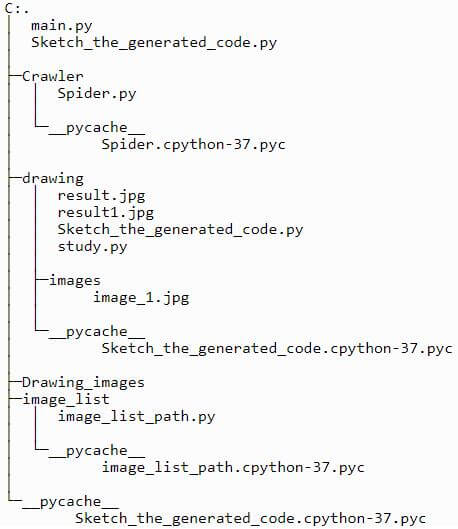程序生成一张素描图。让自己也是一个素描“大师”。废话不多说,直接先来看看效果吧。* B3 u1 [* y* d B

 ! ~ c( B& A* I; A4 z
! ~ c( B& A* I; A4 z
1. 流程分析3 j4 m7 \! D/ `

# u @2 M; Q8 M( D& F2. 具体实现
! a! b5 i( c$ r5 e1 S" W安装所需要的库:. W1 o1 k* a/ G; M0 I y( x
pip install opencv-python
导入所需要的库:! \3 q T) A9 t ~, N
import cv2
编写主体代码也是非常的简单的,代码如下:
: [. I! { M/ P: F( timport cv2
SRC = 'images/image_1.jpg'
image_rgb = cv2.imread(SRC)
image_gray = cv2.cvtColor(image_rgb, cv2.COLOR_BGR2GRAY)
image_blur = cv2.GaussianBlur(image_gray, ksize=(21, 21), sigmaX=0, sigmaY=0)
image_blend = cv2.divide(image_gray, image_blur, scale=255)
cv2.imwrite('result.jpg', image_blend)
上面的代码其实并不难,接下来为了能更好的理解,编写如下代码:
/ _9 y# V0 P; k8 J"""
project = 'Code', file_name = 'study.py', author = ''
time = '2020/5/19 8:35', product_name = PyCharm
code is far away from bugs with the god animal protecting
I love animals. They taste delicious.
"""
import cv2
# 原图路径
SRC = 'images/image_1.jpg'
# 读取图片
image_rgb = cv2.imread(SRC)
# cv2.imshow('rgb', image_rgb) # 原图
# cv2.waitKey(0)
# exit()
image_gray = cv2.cvtColor(image_rgb, cv2.COLOR_BGR2GRAY)
# cv2.imshow('gray', image_gray) # 灰度图
# cv2.waitKey(0)
# exit()
image_bulr = cv2.GaussianBlur(image_gray, ksize=(21, 21), sigmaX=0, sigmaY=0)
cv2.imshow('image_blur', image_bulr) # 高斯虚化
cv2.waitKey(0)
exit()
# divide: 提取两张差别较大的线条和内容
image_blend = cv2.divide(image_gray, image_bulr, scale=255)
# cv2.imshow('image_blend', image_blend) # 素描
cv2.waitKey(0)
# cv2.imwrite('result1.jpg', image_blend)
上面的代码是在原有的基础上添加了一些实时展示的代码来理解,其实有人会问,我用软件不就可以直接生成素描图吗?那程序的好处是什么?程序的好处就是如果你的图片量多的话,这个时候使用程序批量生成也是非常方便高效的。
4 Y" [! D }& i6 m" c% p3. 百度图片爬虫+生成素描图
" J6 H) @" N% k$ D. T2 e+ x 不过,这还不是我们的海量图片,为了达到海量这个词,写了一个百度图片爬虫,不过本文不是教如何写爬虫代码的,这里直接放出爬虫代码,符和软件工程规范:
2 ?( i+ e' `% P/ o0 r# Crawler.Spider.py
import re
import os
import time
import collections
from collections import namedtuple
import requests
from concurrent import futures
from tqdm import tqdm
from enum import Enum
BASE_URL = 'https://image.baidu.com/search/acjson?tn=resultjson_com&ipn=rj&ct=201326592&is=&fp=result&queryWord={keyword}&cl=2&lm=-1&ie=utf-8&oe=utf-8&adpicid=&st=-1&z=&ic=&hd=&latest=©right=&word={keyword}&s=&se=&tab=&width=&height=&face=0&istype=2&qc=&nc=1&fr=&expermode=&force=&pn={page}&rn=30&gsm=&1568638554041='
HEADERS = {
'Referer': 'http://image.baidu.com/search/index?tn=baiduimage&ipn=r&ct=201326592&cl=2&lm=-1&st=-1&fr=&sf=1&fmq=1567133149621_R&pv=&ic=0&nc=1&z=0&hd=0&latest=0©right=0&se=1&showtab=0&fb=0&width=&height=&face=0&istype=2&ie=utf-8&sid=&word=%E5%A3%81%E7%BA%B8',
'User-Agent': 'Mozilla/5.0 (Windows NT 10.0; Win64; x64) AppleWebKit/537.36 (KHTML, like Gecko) Chrome/75.0.3770.100 Safari/537.36',
'X-Requested-With': 'XMLHttpRequest', }
class BaiDuSpider:
def __init__(self, max_works, images_type):
self.max_works = max_works
self.HTTPStatus = Enum('Status', ['ok', 'not_found', 'error'])
self.result = namedtuple('Result', 'status data')
self.session = requests.session()
self.img_type = images_type
self.img_num = None
self.headers = HEADERS
self.index = 1
def get_img(self, img_url):
res = self.session.get(img_url)
if res.status_code != 200:
res.raise_for_status()
return res.content
def download_one(self, img_url, verbose):
try:
image = self.get_img(img_url)
except requests.exceptions.HTTPError as e:
res = e.response
if res.status_code == 404:
status = self.HTTPStatus.not_found
msg = 'not_found'
else:
raise
else:
self.save_img(self.img_type, image)
status = self.HTTPStatus.ok
msg = 'ok'
if verbose:
print(img_url, msg)
return self.result(status, msg)
def get_img_url(self):
urls = [BASE_URL.format(keyword=self.img_type, page=page) for page in self.img_num]
for url in urls:
res = self.session.get(url, headers=self.headers)
if res.status_code == 200:
img_list = re.findall(r'"thumbURL":"(.*?)"', res.text)
# 返回出图片地址,配合其他函数运行
yield {img_url for img_url in img_list}
elif res.status_code == 404:
print('-----访问失败,找不到资源-----')
yield None
elif res.status_code == 403:
print('*****访问失败,服务器拒绝访问*****')
yield None
else:
print('>>> 网络连接失败 <<<')
yield None
def download_many(self, img_url_set, verbose=False):
if img_url_set:
counter = collections.Counter()
with futures.ThreadPoolExecutor(self.max_works) as executor:
to_do_map = {}
for img in img_url_set:
future = executor.submit(self.download_one, img, verbose)
to_do_map[future] = img
done_iter = futures.as_completed(to_do_map)
if not verbose:
done_iter = tqdm(done_iter, total=len(img_url_set))
for future in done_iter:
try:
res = future.result()
except requests.exceptions.HTTPError as e:
error_msg = 'HTTP error {res.status_code} - {res.reason}'
error_msg = error_msg.format(res=e.response)
except requests.exceptions.ConnectionError:
error_msg = 'ConnectionError error'
else:
error_msg = ''
status = res.status
if error_msg:
status = self.HTTPStatus.error
counter[status] += 1
if verbose and error_msg:
img = to_do_map[future]
print('***Error for {} : {}'.format(img, error_msg))
return counter
else:
pass
def save_img(self, img_type, image):
with open('{}/{}.jpg'.format(img_type, self.index), 'wb') as f:
f.write(image)
self.index += 1
def what_want2download(self):
# self.img_type = input('请输入你想下载的图片类型,什么都可以哦~ >>> ')
try:
os.mkdir(self.img_type)
except FileExistsError:
pass
img_num = input('请输入要下载的数量(1位数代表30张,列如输入1就是下载30张,2就是60张):>>> ')
while True:
if img_num.isdigit():
img_num = int(img_num) * 30
self.img_num = range(30, img_num + 1, 30)
break
else:
img_num = input('输入错误,请重新输入要下载的数量>>> ')
def main(self):
# 获取图片类型和下载的数量
total_counter = {}
self.what_want2download()
for img_url_set in self.get_img_url():
if img_url_set:
counter = self.download_many(img_url_set, False)
for key in counter:
if key in total_counter:
total_counter[key] += counter[key]
else:
total_counter[key] = counter[key]
else:
# 可以为其添加报错功能
pass
time.sleep(.5)
return total_counter
if __name__ == '__main__':
max_works = 20
bd_spider = BaiDuSpider(max_works)
print(bd_spider.main())
# Sketch_the_generated_code.py
import cv2
def drawing(src, id=None):
image_rgb = cv2.imread(src)
image_gray = cv2.cvtColor(image_rgb, cv2.COLOR_BGR2GRAY)
image_blur = cv2.GaussianBlur(image_gray, ksize=(21, 21), sigmaX=0, sigmaY=0)
image_blend = cv2.divide(image_gray, image_blur, scale=255)
cv2.imwrite(f'Drawing_images/result-{id}.jpg', image_blend)
# image_list.image_list_path.py
import os
from natsort import natsorted
IMAGES_LIST = []
def image_list(path):
global IMAGES_LIST
for root, dirs, files in os.walk(path):
# 按文件名排序
# files.sort()
files = natsorted(files)
# 遍历所有文件
for file in files:
# 如果后缀名为 .jpg
if os.path.splitext(file)[1] == '.jpg':
# 拼接成完整路径
# print(file)
filePath = os.path.join(root, file)
print(filePath)
# 添加到数组
IMAGES_LIST.append(filePath)
return IMAGES_LIST
# main.py
import time
from Sketch_the_generated_code import drawing
from Crawler.Spider import BaiDuSpider
from image_list.image_list_path import image_list
import os
MAX_WORDS = 20
if __name__ == '__main__':
# now_path = os.getcwd()
# img_type = 'ai'
img_type = input('请输入你想下载的图片类型,什么都可以哦~ >>> ')
bd_spider = BaiDuSpider(MAX_WORDS, img_type)
print(bd_spider.main())
time.sleep(10) # 这里设置睡眠时间,让有足够的时间去添加,这样读取就,去掉或者太短会报错,所以
for index, path in enumerate(image_list(img_type)):
drawing(src = path, id = index)
所以最终的目录结构如下所示:
. N G/ ?) i% J) M7 Z

|  |手机版|小黑屋|paopaomj.COM
(
|手机版|小黑屋|paopaomj.COM
( ![]() 渝ICP备18007172号|
渝ICP备18007172号|![]() 渝公网安备50010502503914号 )
渝公网安备50010502503914号 )